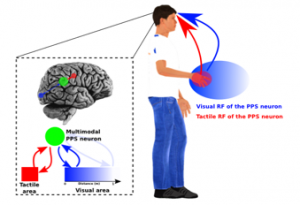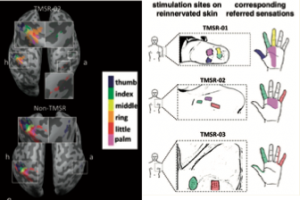 The main goal of the lab is understanding how the human brain builds a representation of the body in space, important for action and perception. To this aim, we use different techniques from cognitive neuroscience, including psychophysics, fMRI, intracranial EEG recording, neuropsychology and neural network modeling to study the multisensory mechanisms of underlying the representation of Peripersonal Space (PPS).
The main goal of the lab is understanding how the human brain builds a representation of the body in space, important for action and perception. To this aim, we use different techniques from cognitive neuroscience, including psychophysics, fMRI, intracranial EEG recording, neuropsychology and neural network modeling to study the multisensory mechanisms of underlying the representation of Peripersonal Space (PPS).
We study 4 main research questions:
Selected publications:
- Serino, A. (2019). Peripersonal space (PPS) as a multisensory interface between the individual and the environment, defining the space of the self. Neuroscience & Biobehavioral Reviews.
https://www.sciencedirect.com/science/article/pii/S0149763418306389 - Serino, A., Akselrod, M., Salomon, R., Martuzzi, R., Blefari, M. L., Canzoneri, E., … & Amoresano, A. (2017). Upper limb cortical maps in amputees with targeted muscle and sensory reinnervation. Brain, 140(11), 2993-3011.
https://academic.oup.com/brain/article/140/11/2993/4568329 - Grivaz, P., Blanke, O., & Serino, A. (2017). Common and distinct brain regions processing multisensory bodily signals for peripersonal space and body ownership. Neuroimage, 147, 602-618.
https://www.sciencedirect.com/science/article/pii/S1053811916307753 - Blanke, O., Slater, M., & Serino, A. (2015). Behavioral, neural, and computational principles of bodily self-consciousness. Neuron, 88(1), 145-166.
https://www.sciencedirect.com/science/article/pii/S0896627315008181 - Teneggi, C., Canzoneri, E., di Pellegrino, G., & Serino, A. (2013). Social modulation of peripersonal space boundaries. Current biology, 23(5), 406-411.
https://www.sciencedirect.com/science/article/pii/S096098221300078X





